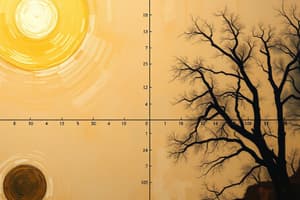Podcast
Questions and Answers
Identify the vertical asymptote(s) of the function $f(x) = \frac{x + 2}{x^2 - 3x - 4}$
Identify the vertical asymptote(s) of the function $f(x) = \frac{x + 2}{x^2 - 3x - 4}$
C and F
Which is the graph of $f(x) = \frac{x - 1}{x^2 - x - 6}$?
Which is the graph of $f(x) = \frac{x - 1}{x^2 - x - 6}$?
- Option A (correct)
- Option C
- Option B
- Option D
Which statement defines the horizontal asymptote?
Which statement defines the horizontal asymptote?
m = n, so y = am / bn is the horizontal asymptote.
What is the horizontal asymptote?
What is the horizontal asymptote?
The graph of the function has a vertical asymptote of $x =$
The graph of the function has a vertical asymptote of $x =$
The graph of the function has a horizontal asymptote of $y =$
The graph of the function has a horizontal asymptote of $y =$
The domain of the function is
The domain of the function is
The range of the function is
The range of the function is
The vertical asymptote is $x =$
The vertical asymptote is $x =$
The horizontal asymptote is $y =$
The horizontal asymptote is $y =$
Select all that are true for $g(x) = \frac{10}{x}$
Select all that are true for $g(x) = \frac{10}{x}$
Which is the graph of $g(x) = \frac{10}{x}$?
Which is the graph of $g(x) = \frac{10}{x}$?
Which is the graph of $y = \frac{2}{x} + 1 - 6$?
Which is the graph of $y = \frac{2}{x} + 1 - 6$?
Name the vertical asymptote(s).
Name the vertical asymptote(s).
Name the horizontal asymptote(s).
Name the horizontal asymptote(s).
What is the domain of the function?
What is the domain of the function?
Which of the following describes the end behavior of $f(x) = \frac{2x}{3x^2 - 3}$?
Which of the following describes the end behavior of $f(x) = \frac{2x}{3x^2 - 3}$?
Which of the following could be the function graphed?
Which of the following could be the function graphed?
Identify the graph of $f(x) = \frac{10 - 10x^2}{x^2}$.
Identify the graph of $f(x) = \frac{10 - 10x^2}{x^2}$.
Which of the following are correct? (Check all that apply)
Which of the following are correct? (Check all that apply)
The vertical asymptote of $f(x) = \frac{c}{x}$, where $c$ is a nonzero real number, is:
The vertical asymptote of $f(x) = \frac{c}{x}$, where $c$ is a nonzero real number, is:
The horizontal asymptote of $f(x) = \frac{c}{x}$ is:
The horizontal asymptote of $f(x) = \frac{c}{x}$ is:
The domain of the function $f(x) = \frac{c}{x}$ is:
The domain of the function $f(x) = \frac{c}{x}$ is:
The range of the function $f(x) = \frac{c}{x}$ is:
The range of the function $f(x) = \frac{c}{x}$ is:
How does the graph of this function compare with the graph of the parent function, $y = \frac{1}{x}$?
How does the graph of this function compare with the graph of the parent function, $y = \frac{1}{x}$?
Which of the following is the function represented by the graph?
Which of the following is the function represented by the graph?
Explain the behavior of the graph of $I$ where $P$ is the power of the sound:
Explain the behavior of the graph of $I$ where $P$ is the power of the sound:
Flashcards are hidden until you start studying
Study Notes
Vertical Asymptotes
- Identify vertical asymptotes in rational functions by finding values that cause the denominator to equal zero.
- For the function ( f(x) = \frac{x + 2}{x^2 - 3x - 4} ), vertical asymptotes are found at ( x = -1 ) and ( x = 2 ).
- The function ( g(x) = \frac{10}{x} ) also has a vertical asymptote at ( x = 0 ).
Horizontal Asymptotes
- The horizontal asymptote can be determined by considering the degrees of the numerator and denominator in rational functions.
- For functions where the degrees of the numerator (m) and denominator (n) are equal, the horizontal asymptote is determined by the ratio of leading coefficients: ( y = \frac{a_m}{b_n} ).
- In the given scenarios, horizontal asymptotes were established at ( y = 1/4 ) and ( y = 0 ).
Domain and Range
- The domain of rational functions is typically all real numbers except those that make the denominator equal zero.
- For certain functions like ( g(x) = \frac{10}{x} ), the domain includes all nonzero real numbers.
- The range similarly consists of all nonzero real numbers in the cases discussed.
End Behavior and Graph Characteristics
- End behavior describes how the graph behaves as values approach infinity or negative infinity.
- For functions like ( f(x) = \frac{2x}{3x^2 - 3} ), various end behaviors can be predicted based on the degree of polynomials.
- Comparing graphs with parent functions, such as ( y = \frac{1}{x} ), is crucial for understanding transformations and behaviors.
Graph Identification
- Several graphs represent different rational functions, and accurate identification is key in analyzing their characteristics.
- Example graphs were mentioned for specific functions, including ( f(x) = \frac{10 - 10x^2}{x^2} ) and others associated with their respective letters in the provided context.
Special Function Behaviors
- For specific functions like ( f(x) = \frac{c}{x} ) (where c is nonzero), key attributes include vertical asymptote at ( x = 0 ), horizontal asymptote at ( y = 0 ), and domain and range of all nonzero real numbers.
- Understanding intensity-related graphs, as referenced, emphasizes the significance of asymptotes in real-life contexts, such as sound intensity diminishing with distance.
True Statements and Core Functions
- It’s essential to evaluate true statements about given functions and their graphs, reinforcing understanding of the mathematical concepts behind rational functions.
Studying That Suits You
Use AI to generate personalized quizzes and flashcards to suit your learning preferences.




